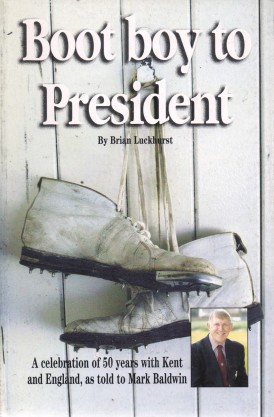From Bootboy to President
Martin Chandler |Published: 2004
Pages: 110
Author: Luckhurst, Brian
Publisher: KOS Media
Rating: 3.5 stars

Some cricket books get the acclaim that they deserve. Anything written by Gideon Haigh , David Frith, or Duncan Hamilton, or anything bearing the imprint of Fairfield Books are examples. Many worthwhile titles are not so fortunate, mainly because the self-publishing writer is unable to attract sufficient publicity and often small or purely local publishers suffer a similar fate. Many good books slip undeservedly into obscurity and Bootboy to President is certainly one of those.
The book is the autobiography of former Kent and England opening batsman Brian Luckhurst . It was written with the assistance of Times journalist Mark Baldwin who did an excellent job. The publishers, KOS Media I have not otherwise encountered, and they appear to be no more. They seem primarily to have, for a number of years, had a stable of local newspapers in Kent together with online news sites. I cannot find any prior or subsequent involvement in publishing books, which I find a little surprising as, in terms of the finished product they certainly did not let Baldwin and Luckhurst down.
The next question, and perhaps it should have been the first, is who was Brian Luckhurst? To those of this reviewer’s generation that question will not need an answer but he is a man, perhaps because he died only a year after this book was published at the relatively early age of 66, whose memory has faded. His main claim to fame was as one of the three opening batsman (the others being Geoffrey Boycott and John Edrich) who led England’s batting in 1970/71 in Australia and made a major contribution to the Ashes victory that Ray Illingworth’s team secured.
After that famous trip Luckhurst enjoyed more success at home against India and Pakistan in 1971, but was less successful when Australia returned in 1972 and by 1973, then aged 34, a couple of unspectacular performances against Rohan Kanhai’s West Indians appeared to have signalled the end of his Test career . That he got another opportunity was thanks to Boycott, Luckhurst picking up the poisoned chalice of a place in the England party to tour Australia in 1974/75 after Boycott decided to begin his three year self-imposed exile from Test cricket. Luckhurst failed at the ‘Gabba and although he defended bravely at the WACA in the second Test a hand injury spared him any further involvement in the battle against Dennis Lillee and Jeff Thomson.
Luckhurst’s back story is an interesting one. There was a slow start. He made his First Class debut as a teenager in 1958 but appeared only six times over his first four summers with Kent. Over the next seven he reinvented himself as a specialist batsman and got his thousand runs per season without ever suggesting that an international breakthrough beckoned. It was 1969, already 30 years of age, when he enjoyed a breakthrough season and forced his way into the England side through weight of runs.
After retiring from the game in 1976 Luckhurst performed a variety of roles at Kent, including coming back as a player once in 1985 during an Injury crisis to face the Australians. Batting at number ten there was no fairytale ending but Luckhurst was unbeaten on nine when his side’s second innings closed. In time, and hence the title of the book, Luckhurst was invited to be President of the club, an appointment that he clearly relished.
The book is not a lengthy one, although at the same time not as short as its 110 pages might suggest given the relatively small font used. The book is extremely well presented, other than the irritation of the text not being justified. The most striking thing about the book is the number of photographs it contains. Altogether there are almost 60, some colour and some black and white, and without exception well chosen and nicely reproduced on good quality paper.
As far as the narrative is concerned the story is, if you are interested in cricket from that era, a fascinating one. The general tenor of the book is one describing a career much enjoyed and although Luckhurst shares with his reader one or two of his disappointments at the way England treated him he does not, as he surely could have done, go on to shed any new light on some of the more interesting characters In English cricket during his time in the game. I am thinking in particular of Boycott, albeit plenty of others have had a lot to say about Yorkshire’s finest, but also Colin Cowdrey who Luckhurst must have known extremely well but whose personality, despite the attentions of a number of writers, remains in some ways elusive.






Leave a comment